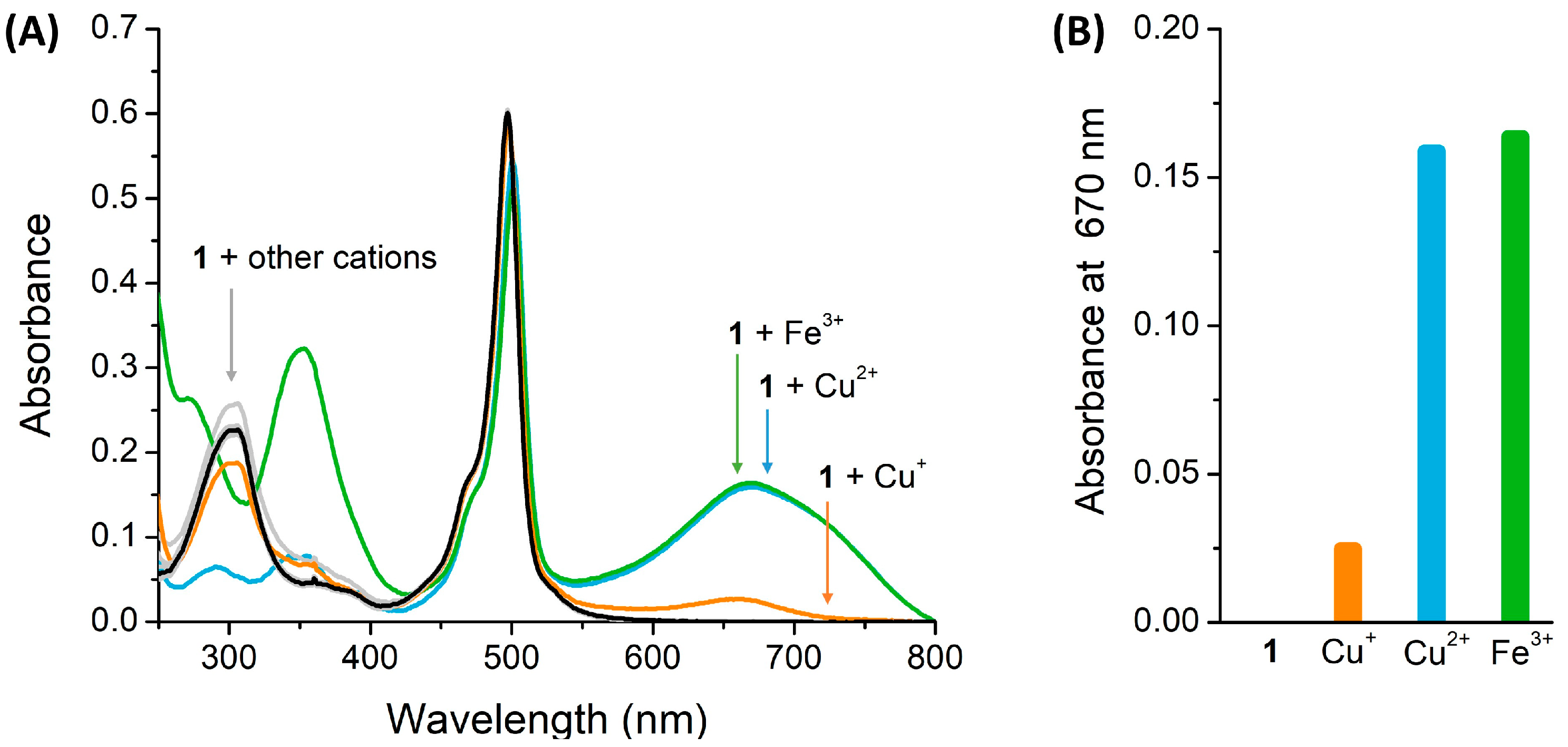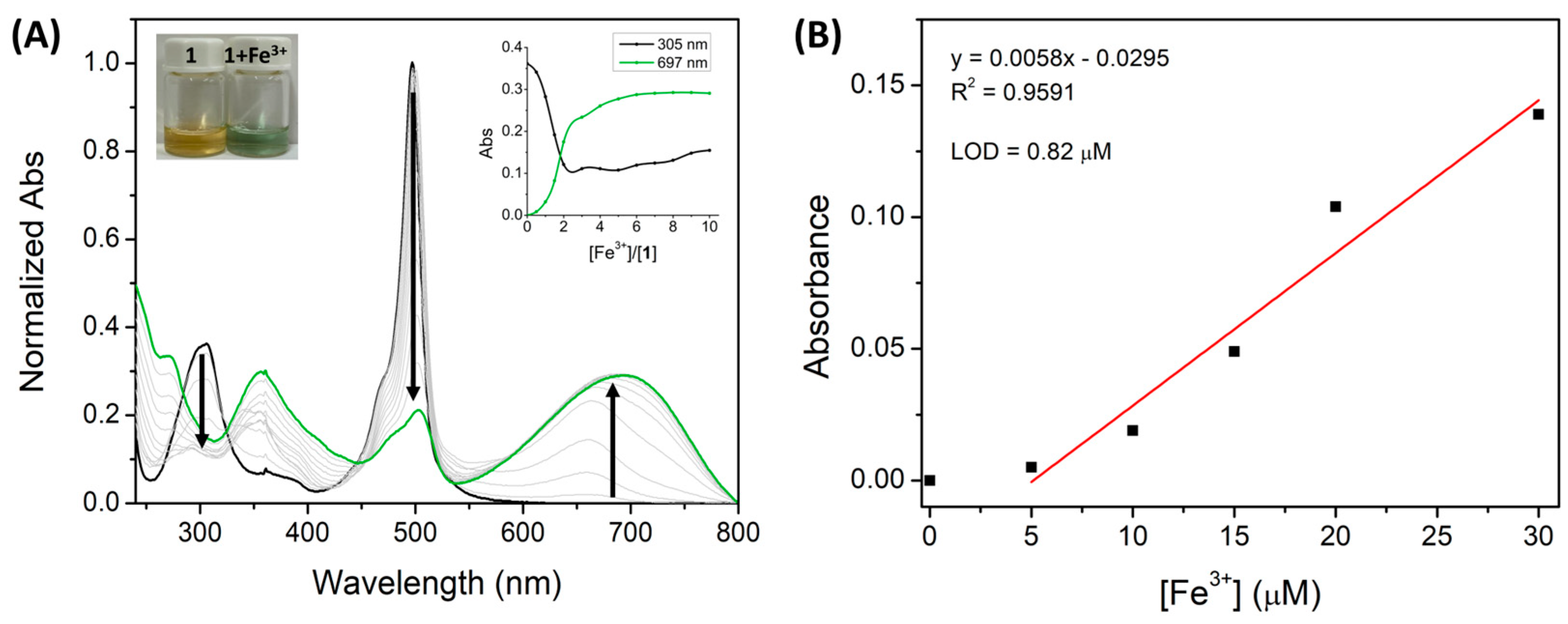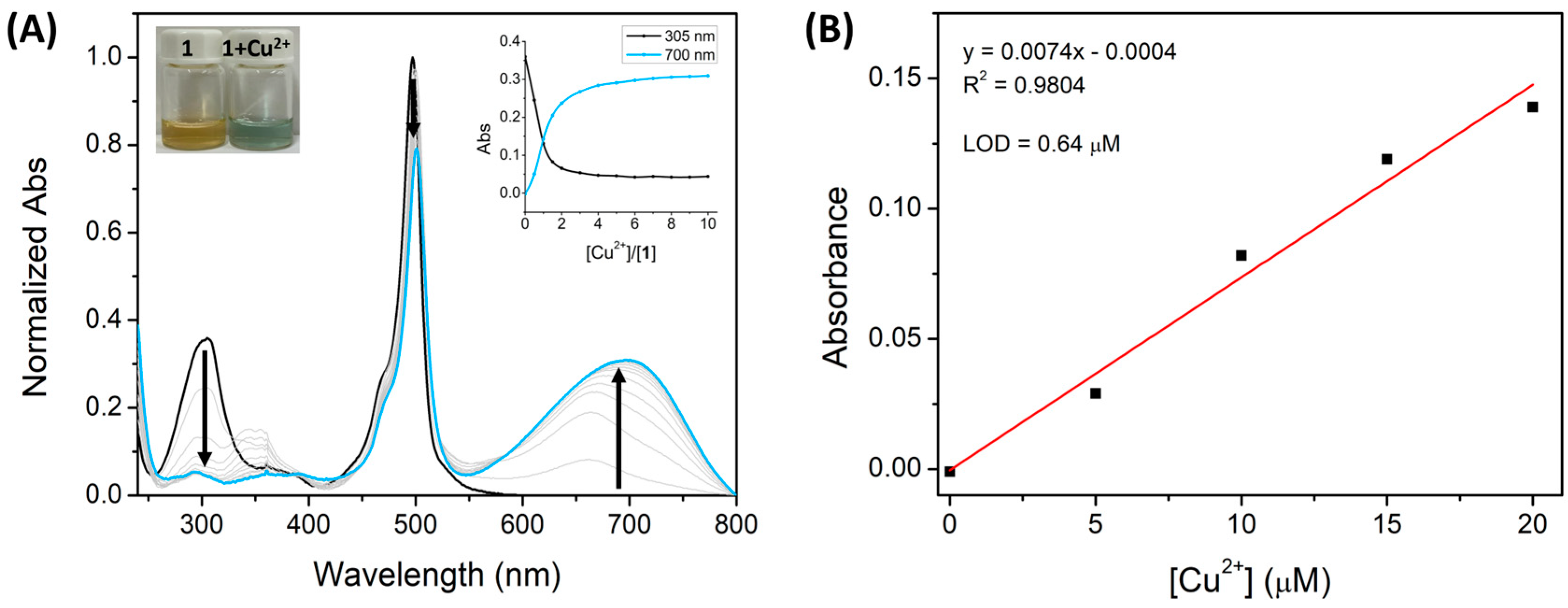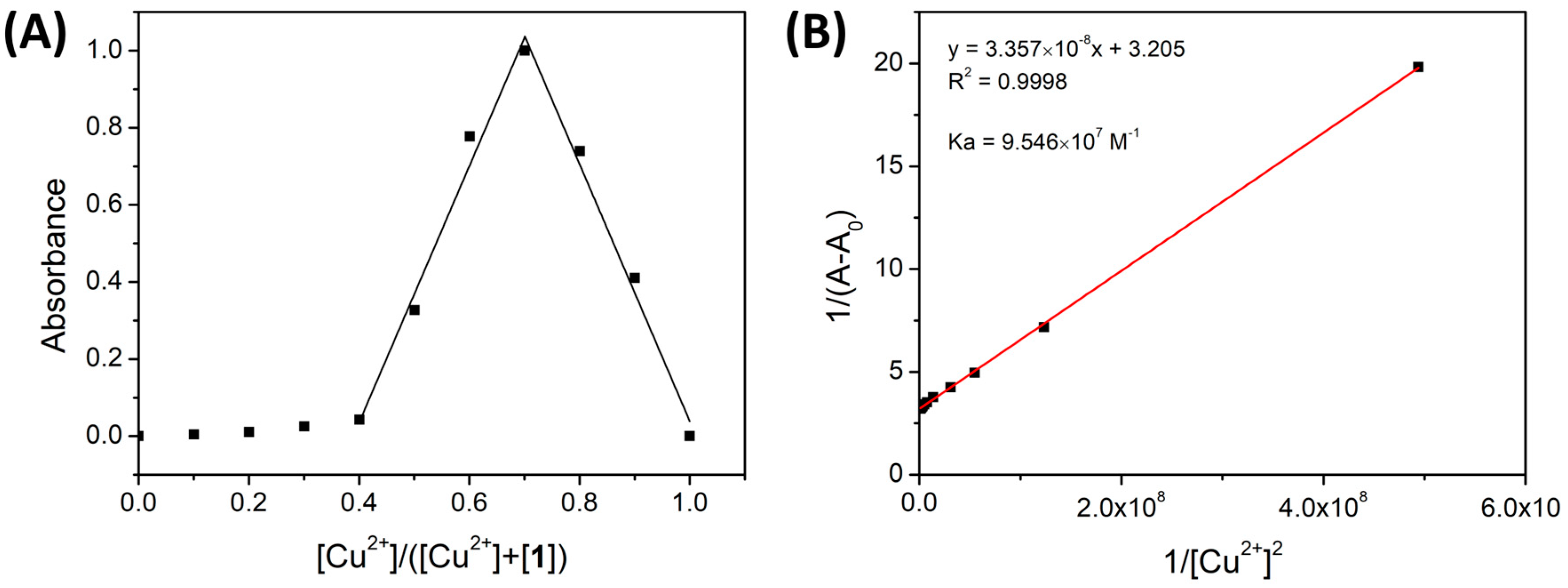Colorimetric Chemosensor for Cu2+ and Fe3+ Based on a meso-Triphenylamine-BODIPY Derivative
Abstract
:1. Introduction
2. Materials and Methods
2.1. Materials
2.2. Synthesis of BODPY Derivative 1
2.3. Photophysical Characterization of BODIPY Derivative 1
2.4. Preliminary Chemosensory Tests
2.5. Spectrophotometric Titrations, Limit of Detection, and Binding Constant
2.6. Job’s Plot
2.7. 1H and 19F NMR Titration
3. Results and Discussion
3.1. Synthesis of BODIPY 1
3.2. Photophysical Characterization of BODIPY Derivative 1
3.3. Preliminary Chemosensing Study
3.4. Spectrophotometric Titrations
3.5. Binding Stoichiometry and Constant
3.6. 1H and 19F NMR Titrations
4. Conclusions
Supplementary Materials
Author Contributions
Funding
Institutional Review Board Statement
Informed Consent Statement
Data Availability Statement
Conflicts of Interest
References
- Mudgal, V.; Madaan, N.; Mudgal, A.; Singh, R.B.; Mishra, S. Effect of Toxic Metals on Human Health. Open Nutraceuticals J. 2010, 3, 94–99. [Google Scholar] [CrossRef] [Green Version]
- Kumar, V.; Parihar, R.D.; Sharma, A.; Bakshi, P.; Singh Sidhu, G.P.; Bali, A.S.; Karaouzas, I.; Bhardwaj, R.; Thukral, A.K.; Gyasi-Agyei, Y.; et al. Global Evaluation of Heavy Metal Content in Surface Water Bodies: A Meta-Analysis Using Heavy Metal Pollution Indices and Multivariate Statistical Analyses. Chemosphere 2019, 236, 124364. [Google Scholar] [CrossRef]
- Tchounwou, P.B.; Yedjou, C.G.; Patlolla, A.K.; Sutton, D.J. Heavy Metal Toxicity and the Environment. In Molecular, Clinical and Environmental Toxicology; Luch, A., Ed.; Experientia Supplementum; Springer: Basel, Switzerland, 2012; Volume 101. [Google Scholar] [CrossRef] [Green Version]
- Moustakas, M. The Role of Metal Ions in Biology, Biochemistry and Medicine. Materials 2021, 14, 549. [Google Scholar] [CrossRef]
- Tsang, T.; Davis, C.I.; Brady, D.C. Copper Biology. Curr. Biol. 2021, 31, R421–R427. [Google Scholar] [CrossRef]
- Jomova, K.; Valko, M. Advances in Metal-Induced Oxidative Stress and Human Disease. Toxicology 2011, 283, 65–87. [Google Scholar] [CrossRef] [PubMed]
- Gupte, A.; Mumper, R.J. Elevated Copper and Oxidative Stress in Cancer Cells as a Target for Cancer Treatment. Cancer Treat. Rev. 2009, 35, 32–46. [Google Scholar] [CrossRef]
- Sirabella, R.; Valsecchi, V.; Anzilotti, S.; Cuomo, O.; Vinciguerra, A.; Cepparulo, P.; Brancaccio, P.; Guida, N.; Blondeau, N.; Canzoniero, L.M.T.; et al. Ionic Homeostasis Maintenance in ALS: Focus on New Therapeutic Targets. Front. Neurosci. 2018, 12, 510. [Google Scholar] [CrossRef] [Green Version]
- El-Nahass, M.N.; Fayed, T.A.; El-Daly, H.A.; Youssif, M.M. Benzothiazole Azo Derivatives as Colorimetric Probes for Optical Recognition of Different Metal Ions and Anions. Appl. Organomet. Chem. 2022, 36, e6703. [Google Scholar] [CrossRef]
- Heo, J.S.; Suh, B.; Kim, C. Selective Detection of Cu2+ by Benzothiazole-Based Colorimetric Chemosensor: A DFT Study. J. Chem. Sci. 2022, 134, 43. [Google Scholar] [CrossRef]
- Chowdhury, S.; Rooj, B.; Dutta, A.; Mandal, U. Review on Recent Advances in Metal Ions Sensing Using Different Fluorescent Probes. J. Fluoresc. 2018, 28, 999–1021. [Google Scholar] [CrossRef] [PubMed]
- Chen, Z.E.; Zang, X.F.; Yang, M.; Zhang, H. A Simple Indolo[2,3-a]Carbazole Based Colorimetric Chemosensor for Simultaneous Detection of Cu2+ and Fe3+ Ions. Spectrochim. Acta A Mol. Biomol. Spectrosc. 2020, 234, 118236. [Google Scholar] [CrossRef]
- Cheng, P.F.; Xu, K.X.; Yao, W.; Xie, E.; Liu, J. Novel Fluorescent Chemosensors Based on Carbazole for Cu2+ and Fe3+ in Aqueous Media. J. Lumin. 2013, 143, 583–586. [Google Scholar] [CrossRef]
- Ghosh, D.; Rhodes, S.; Winder, D.; Atkinson, A.; Gibson, J.; Ming, W.; Padgett, C.; Landge, S.; Aiken, K. Spectroscopic Investigation of Bis-Appended 1,2,3-Triazole Probe for the Detection of Cu(II) Ion. J. Mol. Struct. 2017, 1134, 638–648. [Google Scholar] [CrossRef] [Green Version]
- Ma, Y.; Leng, T.; Qu, Y.; Wang, C.; Shen, Y.; Zhu, W. A Dual Chemosensor for Cu2+ and Fe3+ based on π-Extend Tetrathiafulvalene Derivative. Tetrahedron 2017, 73, 14–20. [Google Scholar] [CrossRef]
- You, G.R.; Park, G.J.; Lee, J.J.; Kim, C. A Colorimetric Sensor for the Sequential Detection of Cu2+ and CN− in Fully Aqueous Media: Practical Performance of Cu2+. Dalton Trans. 2015, 44, 9120–9129. [Google Scholar] [CrossRef] [PubMed]
- He, Y.; Mei, J.; Zhou, M.; Zhang, Y.; Liang, Q.; Xu, S.; Li, Z. Colorimetric and Fluorescent Probe for Highly Selective and Sensitive Recognition of Cu2+ and Fe3+ Based on Asymmetric Squaraine Dye. Inorg. Chem. Commun. 2022, 142, 109592. [Google Scholar] [CrossRef]
- Alam, M.Z.; Alimuddin; Khan, S.A. A Review on Schiff Base as a Versatile Fluorescent Chemo-Sensors Tool for Detection of Cu2+ and Fe3+ Metal Ion. J. Fluoresc. 2023, 33, 1241–1272. [Google Scholar] [CrossRef]
- Pattaweepaiboon, S.; Foytong, W.; Phiromphu, N.; Nanok, T.; Kaewchangwat, N.; Suttisintong, K.; Sirisaksoontorn, W. Spirooxazine-Based Dual-Sensing Probe for Colorimetric Detection of Cu2+ and Fe3+ and Its Application in Drinking Water and Rice Quality Monitoring. ACS Omega 2022, 7, 18671–18680. [Google Scholar] [CrossRef]
- Liu, M.; Ma, S.; She, M.; Chen, J.; Wang, Z.; Liu, P.; Zhang, S.; Li, J. Structural Modification of BODIPY: Improve Its Applicability. Chin. Chem. Lett. 2019, 30, 1815–1824. [Google Scholar] [CrossRef]
- Li, F.Z.; Yin, J.F.; Kuang, G.C. BODIPY-Based Supramolecules: Construction, Properties and Functions. Coord. Chem. Rev. 2021, 448, 214157. [Google Scholar] [CrossRef]
- Nootem, J.; Sattayanon, C.; Daengngern, R.; Kamkaew, A.; Wattanathana, W.; Wannapaiboon, S.; Rashatasakhon, P.; Chansaenpak, K. Bodipy-Pyridylhydrazone Probe for Fluorescence Turn-on Detection of Fe3+ and Its Bioimaging Application. Chemosensors 2021, 9, 165. [Google Scholar] [CrossRef]
- Li, S.; Cao, D.; Hu, Z.; Li, Z.; Meng, X.; Han, X.; Ma, W. A Chemosensor with a Paddle Structure Based on a BODIPY Chromophore for Sequential Recognition of Cu2+ and HSO3−. RSC Adv. 2019, 9, 34652–34657. [Google Scholar] [CrossRef] [PubMed]
- Saiyasombat, W.; Nuchpun, S.; Katewongsa, K.P.; Pornsuwan, S.; Weigand, J.J.; Kiatisevi, S. A Turn-on Bis-BODIPY Chemosensor for Copper Recognition Based on the in Situ Generation of a Benzimidazole-Triazole Receptor and Its Applications in Bioimaging. New J. Chem. 2022, 46, 22525–22532. [Google Scholar] [CrossRef]
- Wang, L.; Fang, G.; Cao, D. A Novel Phenol-Based BODIPY Chemosensor for Selective Detection Fe3+ with Colorimetric and Fluorometric Dual-Mode. Sens. Actuators B Chem. 2015, 207, 849–857. [Google Scholar] [CrossRef]
- Senthil Murugan, A.; Vidhyalakshmi, N.; Ramesh, U.; Annaraj, J. In Vivo Bio-Imaging Studies of Highly Selective, Sensitive Rhodamine Based Fluorescent Chemosensor for the Detection of Cu2+/Fe3+ Ions. Sens. Actuators B Chem. 2018, 274, 22–29. [Google Scholar] [CrossRef]
- Pinto, S.C.S.; Gonçalves, R.C.R.; Costa, S.P.G.; Raposo, M.M.M. Synthesis, Characterization and Evaluation of a Carbazolyl-BODIPY as a Fluorimetric Chemosensor for F−. Chem. Proc. 2022, 8, 20. [Google Scholar] [CrossRef]
- Gonçalves, R.C.R.; Pinto, S.C.S.; Costa, S.P.G.; Raposo, M.M.M. Anion Colorimetric Chemosensor Based on a Benzimidazole-Functionalized BODIPY Derivative. Chem. Proc. 2022, 8, 90. [Google Scholar] [CrossRef]
- Gonçalves, R.C.R.; Belmonte-Reche, E.; Pina, J.; Costa da Silva, M.; Pinto, S.C.S.; Gallo, J.; Costa, S.P.G.; Raposo, M.M.M. Bioimaging of Lysosomes with a BODIPY pH-Dependent Fluorescent Probe. Molecules 2022, 27, 8065. [Google Scholar] [CrossRef]
- Gonçalves, R.C.R.; Pina, J.; Costa, S.P.G.; Raposo, M.M.M. Synthesis and Characterization of Aryl-Substituted BODIPY Dyes Displaying Distinct Solvatochromic Singlet Oxygen Photosensitization Efficiencies. Dyes Pigm. 2021, 196, 109784. [Google Scholar] [CrossRef]
- Gonçalves, R.C.R.; Nogueira, M.B.; Costa, S.P.G.; Raposo, M.M.M. Functionalized BODIPY Derivatives as Potential Fluorescent Labels. Proceedings 2019, 9, 36. [Google Scholar] [CrossRef]
- Gonçalves, R.C.R.; Pinto, S.C.S.; Costa, S.P.G.; Raposo, M.M.M. A Meso-Triphenylamine-BODIPY Derivative for the Optical Chemosensing of Metal Ions. Chem. Proc. 2021, 3, 65. [Google Scholar] [CrossRef]
- Demasa, J.N.; Crosby, G.A. The Measurement of Photoluminescence Quantum Yields A Review. J. Phys. Chem. 1971, 75, 991–1028. [Google Scholar] [CrossRef]
- Benesi, H.A.; Hildebrand, J.H. A Spectrophotometric Investigation of the Interaction of Iodine with Aromatic Hydrocarbons. J. Am. Chem. Soc. 1949, 71, 2703–2707. [Google Scholar] [CrossRef]
- Sengupta, P.; Ganguly, A.; Bose, A. A Phenolic Acid Based Colourimetric ‘Naked-Eye’ Chemosensor for the Rapid Detection of Cu(II) Ions. Spectrochim. Acta A Mol. Biomol. Spectrosc. 2018, 198, 204–211. [Google Scholar] [CrossRef]
- Huang, Q.; Peng, Z.; Xie, X.; Tang, Z.; Lei, M. Triarylamine-Bonded Binaphthyl Derivatives as Fluorescence Quenching Probes for Fe3+: An Insight into the Mechanism Based on A Single Binding Site. ChemistrySelect 2019, 4, 13490–13495. [Google Scholar] [CrossRef]
- Loudet, A.; Burgess, K. BODIPY Dyes and Their Derivatives: Syntheses and Spectroscopic Properties. Chem. Rev. 2007, 107, 4891–4932. [Google Scholar] [CrossRef]
- Liao, J.; Wang, Y.; Xu, Y.; Zhao, H.; Xiao, X.; Yang, X. Synthesis, Optical and Electrochemical Properties of Novel Meso-Triphenylamine-BODIPY Dyes with Aromatic Moieties at 3,5-Positions. Tetrahedron 2015, 71, 5078–5084. [Google Scholar] [CrossRef]
- Shen, B.X.; Qian, Y. Triphenylamine-BODIPY Fluorescent Dendron: Click Synthesis and Fluorometric Chemodosimeter for Hg2+, Fe3+ Based on the C=N Bond. ChemistrySelect 2017, 2, 2406–2413. [Google Scholar] [CrossRef]
- Li, H.; Li, L.; Yin, B. Highly Selective Fluorescent Chemosensor for Fe3+ Detection Based on Diaza-18-Crown-6 Ether Appended with Dual Coumarins. Inorg. Chem. Commun. 2014, 42, 1–4. [Google Scholar] [CrossRef]
- Pungut, N.A.S.; Tan, C.H.; Saad, H.M.; Sim, K.S.; Tiong, S.Y.X.; Ang, C.W.; Gan, C.H.; Kong, K.V.; Tan, K.W. A New Cinnamaldehyde-Rhodamine Based Dual Chemosensor for Cu2+ and Fe3+ and Its Applicability in Live Cell Imaging. J. Photochem. Photobiol. A Chem. 2023, 438, 114540. [Google Scholar] [CrossRef]
- Lee, Y.F.; Deng, T.W.; Chiu, W.J.; Wei, T.Y.; Roy, P.; Huang, C.C. Visual Detection of Copper(II) Ions in Blood Samples by Controlling the Leaching of Protein-Capped Gold Nanoparticles. Analyst 2012, 137, 1800–1806. [Google Scholar] [CrossRef] [PubMed]
- Sherwood, R.A. Haemoglobins (Hemoglobins). In Encyclopedia of Analytical Science; Worsfold, P., Townshend, A., Poole, C., Eds.; Elsevier: Amsterdam, The Netherlands, 2005; pp. 223–229. [Google Scholar]
- World Health Organization. Guidelines for Drinking-Water Quality: Second Addendum, 3rd ed.; World Health Organization: Geneva, Switzerland, 2008; Volume 1.
- Sasan, S.; Chopra, T.; Gupta, A.; Tsering, D.; Kapoor, K.K.; Parkesh, R. Fluorescence “Turn-Off” and Colorimetric Sensor for Fe2+, Fe3+, and Cu2+ Ions Based on a 2,5,7-Triarylimidazopyridine Scaffold. ACS Omega 2022, 7, 11114–11125. [Google Scholar] [CrossRef]
- Wang, J.; Wei, T.; Ma, F.; Li, T.; Niu, Q. A Novel Fluorescent and Colorimetric Dual-Channel Sensor for the Fast, Reversible and Simultaneous Detection of Fe3+ and Cu2+ Based on Terthiophene Derivative with High Sensitivity and Selectivity. J. Photochem. Photobiol. A Chem. 2019, 383, 111982. [Google Scholar] [CrossRef]
- Na, L.P.; Li, M.; La, Y.T.; Dong, W.K. A Novel Fluorometric and Colorimetric Dual-Channel Single-Armed Salamo-like Chemosensor for the Fast, Reversible and Simultaneous Detection of Fe3+ and Cu2+ Ions. Inorganica Chim. Acta 2022, 537, 120932. [Google Scholar] [CrossRef]
- Gahlyan, P.; Bawa, R.; Jain, H.; Dalela, M.; Joshi, A.; Ramachandran, C.N.; Prasad, A.K.; Kaur, A.; Kumar, R. Isatin-Triazole-Functionalized Rhodamine: A Dual Sensor for Cu2+ and Fe3+ Ions and Its Application to Cell Imaging. ChemistrySelect 2019, 4, 7532–7540. [Google Scholar] [CrossRef]
- Narayanaswamy, N.; Govindaraju, T. Aldazine-Based Colorimetric Sensors for Cu2+ and Fe3+. Sens. Actuators B Chem. 2012, 161, 304–310. [Google Scholar] [CrossRef]
- Ghule, N.V.; Bhosale, R.S.; Puyad, A.L.; Bhosale, S.V.; Bhosale, S.V. Naphthalenediimide Amphiphile Based Colorimetric Probe for Recognition of Cu2+ and Fe3+ Ions. Sens. Actuators B Chem. 2016, 227, 17–23. [Google Scholar] [CrossRef]
- Spangenberg, M.; Bryant, J.I.; Gibson, S.J.; Mousley, P.J.; Ramachers, Y.; Bell, G.R. Ultraviolet Absorption of Contaminants in Water. Sci. Rep. 2021, 11, 3682. [Google Scholar] [CrossRef]
- Paganin-Gioanni, A.; Bellard, E.; Paquereau, L.; Ecochard, V.; Golzio, M.; Teissié, J. Fluorescence Imaging Agents in Cancerology. Radiol. Oncol. 2010, 44, 142–148. [Google Scholar] [CrossRef] [Green Version]
- Jo, T.G.; Na, Y.J.; Lee, J.J.; Lee, M.M.; Lee, S.Y.; Kim, C. A Multifunctional Colorimetric Chemosensor for Cyanide and Copper(II) Ions. Sens. Actuators B Chem. 2015, 211, 498–506. [Google Scholar] [CrossRef]
- Farfán-Paredes, M.; González-Antonio, O.; Tahuilan-Anguiano, D.E.; Peón, J.; Ariza, A.; Lacroix, P.G.; Santillan, R.; Farfán, N. Physicochemical and Computational Insight of 19F NMR and Emission Properties of: Meso-(o-Aryl)-BODIPYs. New J. Chem 2020, 44, 19459–19471. [Google Scholar] [CrossRef]
- Kawakami, J.; Sasaki, Y.; Yanase, K.; Ito, S. Benzo-Fused BODIPY Derivative as a Fluorescent Chemosensor for Fe3+, Cu2+, and Al3+. Trans. Mat. Res. Soc. Jpn. 2019, 44, 69–73. [Google Scholar] [CrossRef] [Green Version]










Disclaimer/Publisher’s Note: The statements, opinions and data contained in all publications are solely those of the individual author(s) and contributor(s) and not of MDPI and/or the editor(s). MDPI and/or the editor(s) disclaim responsibility for any injury to people or property resulting from any ideas, methods, instructions or products referred to in the content. |
© 2023 by the authors. Licensee MDPI, Basel, Switzerland. This article is an open access article distributed under the terms and conditions of the Creative Commons Attribution (CC BY) license (https://creativecommons.org/licenses/by/4.0/).
Share and Cite
Pinto, S.C.S.; Gonçalves, R.C.R.; Costa, S.P.G.; Raposo, M.M.M. Colorimetric Chemosensor for Cu2+ and Fe3+ Based on a meso-Triphenylamine-BODIPY Derivative. Sensors 2023, 23, 6995. https://doi.org/10.3390/s23156995
Pinto SCS, Gonçalves RCR, Costa SPG, Raposo MMM. Colorimetric Chemosensor for Cu2+ and Fe3+ Based on a meso-Triphenylamine-BODIPY Derivative. Sensors. 2023; 23(15):6995. https://doi.org/10.3390/s23156995
Chicago/Turabian StylePinto, Sónia C. S., Raquel C. R. Gonçalves, Susana P. G. Costa, and M. Manuela M. Raposo. 2023. "Colorimetric Chemosensor for Cu2+ and Fe3+ Based on a meso-Triphenylamine-BODIPY Derivative" Sensors 23, no. 15: 6995. https://doi.org/10.3390/s23156995
APA StylePinto, S. C. S., Gonçalves, R. C. R., Costa, S. P. G., & Raposo, M. M. M. (2023). Colorimetric Chemosensor for Cu2+ and Fe3+ Based on a meso-Triphenylamine-BODIPY Derivative. Sensors, 23(15), 6995. https://doi.org/10.3390/s23156995







